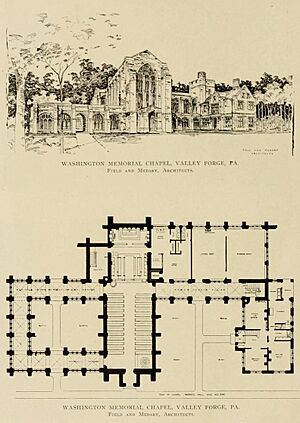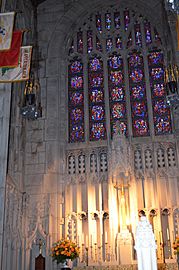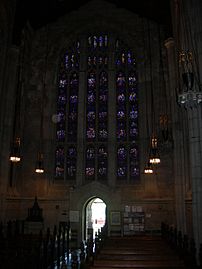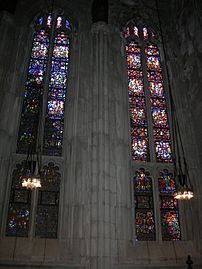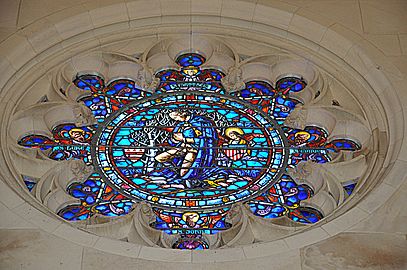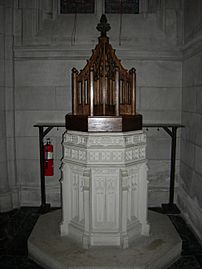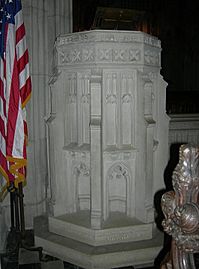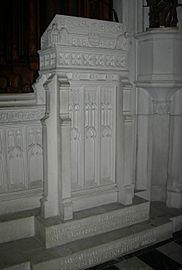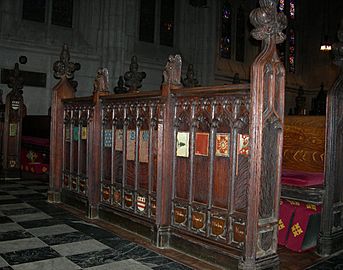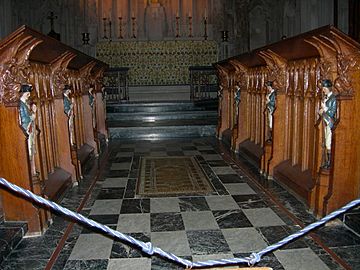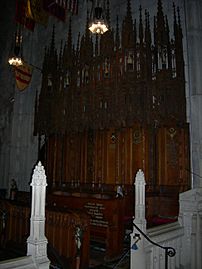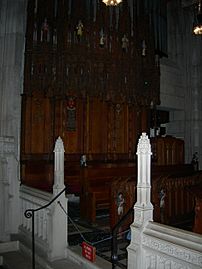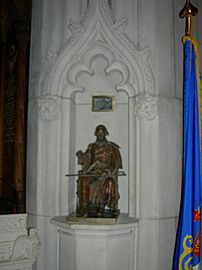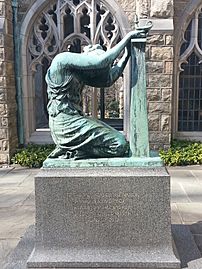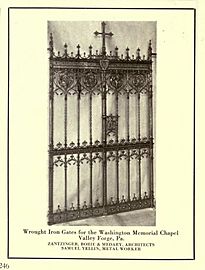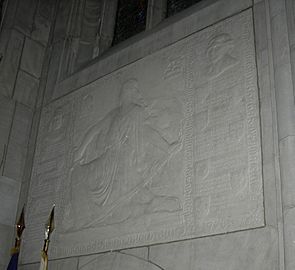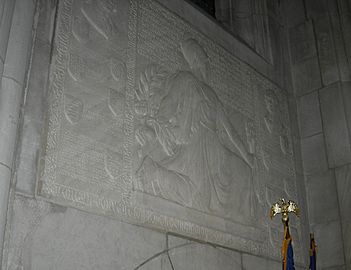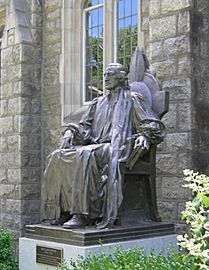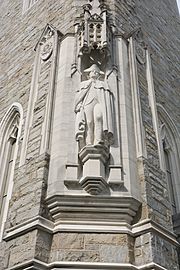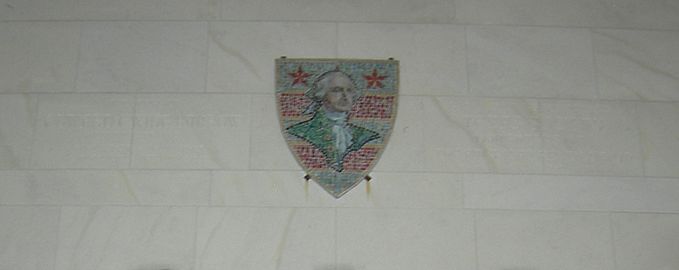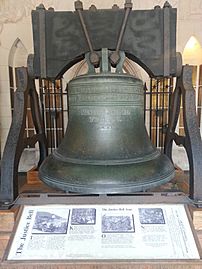Washington Memorial Chapel facts for kids
Quick facts for kids Washington Memorial Chapel |
|
|---|---|
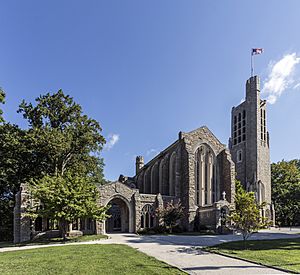 |
|
| 40°06′16.3″N 75°26′16.6″W / 40.104528°N 75.437944°W | |
| Location | Montgomery, Pennsylvania |
| Country | United States |
| Denomination | Episcopalian |
| History | |
| Founded | 1903 |
| Dedication | 1904 |
| Administration | |
| Archdiocese | Province III |
| Diocese | Pennsylvania |
The Washington Memorial Chapel is a special church located inside Valley Forge National Historical Park in Valley Forge, Pennsylvania. It's a national memorial built to honor General George Washington, who was a very important leader in American history. This chapel is also an active church for the Episcopal faith.
The idea for the church came from a sermon by Reverend Dr. W. Herbert Burk. He was an Anglican minister and later became the first leader of this church. The building was designed by an architect named Milton B. Medary. The chapel was added to the National Register of Historic Places on May 1, 2017, and is currently being restored to keep it beautiful. It is located in Upper Merion Township.
Contents
History of the Washington Memorial Chapel
Reverend Burk, who had the idea for the chapel, was a church leader in nearby Norristown. Money for the chapel was collected bit by bit. Its stone walls were built slowly, "a few feet at a time." Reverend Burk also worked hard to protect Valley Forge and helped start the Valley Forge Museum of American History. This museum later became the Valley Forge Historical Society.
Before this chapel, another attempt was made in 1885 to build a memorial church at Valley Forge. A Baptist minister named James M. Guthrie started raising money and building, but he ran out of funds.
The cornerstone for the current chapel was placed on June 19, 1903. This date marked 125 years since the Continental Army left Valley Forge. The land for the chapel was given by the I. Heston Todd family. A small wooden building was used before the main stone chapel was finished. President Theodore Roosevelt visited the site in 1904 and gave a speech. The original wooden building was then named the Theodore Roosevelt Chapel. It was taken down after the main stone chapel was completed.
The outside of the Washington Memorial Chapel was finished in 1917. The inside was completed in 1921. Today, it serves as a welcoming place for visitors to Valley Forge National Historical Park. It is open for everyone to visit.
Many skilled artists worked on the chapel. A famous metalworker named Samuel Yellin created the beautiful iron gates, hardware, and locks. Other artists made sculptures, stonework, stained glass, and metal pieces. The wooden parts inside the chapel were made by a cabinetmaker named Edward Maene.
Even though the chapel is in the middle of the park, it actually belongs to the Episcopal Church, not the park itself. Across from the chapel, there is a small model of the Washington Monument. This marks the grave of Lieutenant John Waterman. The Bell Tower holds the DAR Patriot Rolls. These lists name people who served in the Revolutionary War.
National Patriots Bell Tower and Carillon
The National Patriots Bell Tower was added to the chapel later. It holds the chapel's carillon, which is a musical instrument made of many bells. This tower is about 102 feet (31 meters) tall. It was built entirely with money raised by members of the National Society of the Daughters of the American Revolution (DAR). They collected funds for over ten years.
Construction of the tower began in 1941. However, it stopped because of World War II. Building started again in 1949. The bell tower was finished and officially opened in 1953.
The Justice Bell: A Symbol of Women's Rights
The Justice Bell, also known as the Women's Liberty Bell, is on permanent display inside the bell tower. It was made in 1915 and looks almost exactly like the famous Liberty Bell. This bell became a very important symbol for the Women's Suffrage movement. This movement worked to get women the right to vote.
In 1920, after traveling around the country to promote the 19th Amendment (which gave women the right to vote), the bell was stored at Valley Forge National Park. It was then moved permanently into the bell tower in 1943.
The Chapel's Carillon Bells
The bell tower has a traditional carillon with a keyboard that controls 58 bells. The first 14 bells were made by the Meneely Bell Foundry. They were put in a temporary wooden tower in 1926. More bells were added over the next thirty years.
Fifty-six bells were installed in the main bell tower in 1953. Two more bells from the Fonderie Paccard in France were added in 1963, bringing the total to 58 bells. A person called a carillonneur plays the bell tower regularly. Both formal and informal concerts are held throughout the year and are open to the public.
Features of the Chapel
Beautiful Stained Glass Windows
The chapel has many beautiful stained glass windows. These were designed by an artist named Nicola D'Ascenzo. Some of the notable windows include:
- George Washington Window: Located on the south wall, it shows 36 scenes from Washington's life.
- Anthony Wayne Window: On the west wall, it shows 12 scenes of American expansion.
- Alexander Hamilton Window: Located on the east wall.
- Martha Washington Window (1918): On the north wall, above the altar.
- Washington at Prayer Window: Found in the carillon tower chamber.
Church Furniture and Woodwork
The chapel also has many pieces of furniture designed by Milton B. Medary. These were carved by Edward Maene. Some of these special pieces include:
- Baptismal font (1907): Made of limestone and oak, used for baptisms.
- Pulpit (1909): Made of limestone, where sermons are given.
- Lectern and Perclose (1909): Made of limestone, used for reading scriptures.
- Altar and reredos (1916): Made of limestone, the main table and screen behind it.
- Litany desk (1916): A small desk made of white oak, used for prayers.
- Pews of the Patriots (1917): Made of white oak, these are the benches where people sit. The front left pew is called the Presidents' Pew. It honors George Washington and James Monroe, who were both future presidents and were at Valley Forge.
- Choir stalls and reredos (1917–21): Made of white oak, these are seats for the choir.
- Prayer Desk (1916): A hand-carved desk dedicated to Anna Morris Holstein. She helped save and preserve Washington’s Headquarters and the first parts of Valley Forge Park. This desk was given by the Daughters of the American Revolution (D.A.R.) and the Patriotic Order Sons of America (POS of A).
Sculptures and Statues
The chapel grounds and interior feature several important sculptures:
- Valley Forge (1878): A small bronze statue of a seated Washington by Franklin Simmons.
- Sacrifice and Devotion (1914): A bronze statue of a grieving mother by Bela Pratt. It is in the Cloister of the Colonies Garden.
- Harrison Memorial Gates (1918): Wrought iron gates by Samuel Yellin at the porch entrance.
- Declaration of Independence Tablet (1926): A limestone carving by Martha Maulsby Hovenden in the nave.
- United States Constitution Tablet (1936): Another limestone carving by Martha Maulsby Hovenden in the nave.
- Bishop William White (1937): A bronze statue by Alexander Stirling Calder.
- George Washington (1953): A limestone statue by C. Paul Jennewein on the outside of the National Patriots Bell Tower.
- Nathanael Greene (2015): A bronze statue by Susie Chisholm on the front lawn.
Other Interesting Features
- Mosaic portrait bust of George Washington: A mosaic by Nicola D'Ascenzo in the bell tower chamber.
- Justice Bell: The historic bell from 1915, also known as the Women's Liberty Bell, located in the National Patriots Bell Tower chamber.
See also
- Valley Forge Pilgrimage
- List of carillons in the United States




